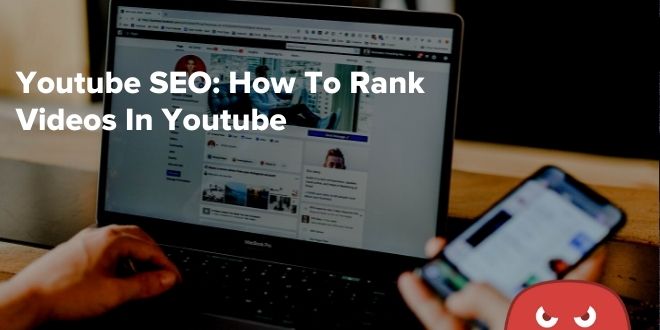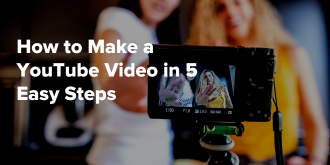Quick Links
Internet users may not wait more than a few seconds for a website to load, but they are willing to spend 100 minutes a day watching online videos.
That’s a clear indicator of the power of video as a medium.
It’s so powerful that we watch 6 billion hours of YouTube content every month.
Here’s another fun fact – did you know that YouTube is the second largest search engine globally, only surpassed by Google?
While not traditionally thought of as a search engine, YouTube has a ranking system for search queries just like Google, and you can optimize your content for it.
81% of internet users watch YouTube. These are leads you could capture and transform into leads for your business. That’s why it’s a no-brainer to use YouTube as part of your digital marketing and content marketing strategies.
Now that you know about the power of video and how it can impact your business – it’s time to learn the fundamentals of YouTube SEO. That way, you can learn how to cater to the algorithm and start dominating the YouTube search.
The following guide will teach you:
- How YouTube ranks videos
- YouTube SEO tips
- How to do keyword research for videos
- How to optimize videos to rank well
- How to build links & promote your videos
Let’s dive in.
Understanding How YouTube Ranks Videos
Google’s ownership of YouTube has helped the platform transform into a powerhouse for video search and secured instant indexation. It also helped YouTube secure a preferential spot in SERPs (for certain queries).
Like Google, YouTube also uses an algorithm that measures a wide array of metrics in order to rank videos.
That means relying solely on keywords and descriptions when it comes to YouTube SEO won’t cut it. Instead, there are a few areas that you can focus on to increase the visibility of your videos:
- Views & frequency
- Watch time
- Number of subscribers
- Annotation linking
- Flagging
- Likes & dislikes
- Shares
- Favorites
YouTube SEO involves the optimization of not only your video content but also your playlists, metadata, and search descriptions.
As with other search engines, YouTube ranking factors are always changing and evolving. Over the years, its algorithm has seen many changes and variations. If you want to stay on top of the game, it’s crucial to keep up with the latest developments at Google and YouTube related to SEO.
In its early days, YouTube ranked videos solely on the number of clicks and views they received.
That quickly proved unsatisfactory – as it led to the proliferation of ‘clickbait’ – a video with a deceitful title and thumbnail with the aim of generating lots of clicks. The content of these videos was often poor or nonexistent, as the goal was only for users to click on the video.
The team at YouTube then began implementing the metrics that you see above. They began ranking videos for viewer satisfaction above all else.
The goal of YouTube’s algorithm is the same as Google’s – to match the user with the highest quality, most relevant content. That pays off big for YouTube, as they keep users on the platform by recommending more videos to watch. It can also pay off for you, too, by greatly increasing the visibility of your videos when you cater to each ranking factor.
Keyword Research For Videos
While you can’t rely primarily on keywords for your entire YouTube SEO strategy – it’s still imperative to use them.
In fact, video keyword research is the first step in developing an SEO strategy for YouTube. Without it, you won’t know how to discover what your target audience searches for online. That’s why it’s crucial to begin by creating a list of common search terms used by your audience.
How do you do that?
A fantastic way to start is to head over to YouTube and use its basic search bar.
Simply pop in a word or phrase related to your niche – and YouTube will suggest a whole bundle of keywords. Let’s say that your business is creating custom backdrops for photography. As such, you do a search for ‘backdrop’ on YouTube, and it spits out:
- Backdrop decoration ideas
- Backdrop stand
- Backdrop photography
- Backdrops for YouTube videos
And voila! You now have 4 top-ranking keyword ideas you can add to your list. The reason why these keyword suggestions are so effective is that they’re search terms that people actually use on YouTube.
As a result, you now have relevant keywords actually used by your target audience.
All that, and you didn’t have to pay a dime for the insight.
Another technique is to find a top-ranked video in your niche. Going with the example above, you would want to use one of the top three videos that pop up when you search ‘backdrop.’ From there, all you have to do is poach the keywords the video uses – and you’ll have a tried and true list of video keywords that you know will rank.
Ranking on YouTube and Google
Having your videos rank on YouTube is great, but do you know what’s even better? Ranking on YouTube AND Google!
While it is true that Google gives YouTube preferential treatment in SERPs, this is only true for certain keywords. These keywords are commonly referred to as “video keywords.”
Before you start working on your next clip, you might want to google your targeted keyword to see if any videos appear on the search engine result pages. If they do, you know have visibility of your competition. From there, you have two options.
You can either choose a different keyword to pursue that doesn’t have videos on Google – or you can attempt to outrank it with superior content. Either way works, although the latter takes a bit more effort.
Yet, learning how to outrank content will provide you with a considerable advantage. If you can create a video that uses the same keywords but has more likes, shares, and subscribers, you’ll take the throne. Outranking content comes in handy for other forms of SEO as well, such as link building.
In general, video keywords make sense only for certain topics. Not every keyword will show videos, so it’s critical to do your homework.
Google will generally display “video results” for the following keywords:
- Product or software reviews.
- Tutorials (e.g., “how to install Adobe Photoshop CS6”)
- How-to keywords (e.g., “how to make a YouTube video”).
- Funny videos (e.g., “funny cat fails”)
- Anything sports, fitness, or fashion-related.
- Current news events
Bottom line: Don’t invest in videos before you check SERPs and evaluate organic potential. The last thing you want is to waste part of your budget on a video that doesn’t rank.
On-Page YouTube Ranking Signals
Now that you know how YouTube’s ranking system works, it’s time to start creating videos. If you don’t have one already, you’ll need to create a new YouTube channel. You’ll want to use your company name and include any necessary branding in your channel name.
For your content, there are several on-page elements that you can optimize to improve your visibility:
Make your video file name your keyword
Since you have a list of relevant keywords to use, it’s time to start placing them in your video content. First and foremost, you’ll want to change your video’s filename (not the title, we’ll get to that in a second) to the target keyword.
Why do that?
Because it’s the first thing YouTube will see when crawling your video.
You see, YouTube’s algorithm has no way to physically watch your video. That means it can’t determine if your content relates to your target keyword. What it can do is read the file name for your video. So if your target keyword is right there, front and center – YouTube will know that your content relates to it.
So do yourself a favor and rename the file from ‘backdrop_video_FINAL3004.mov’ to ‘backdrop-decoration-ideas.mov.’
Just like that, you’ve let YouTube know that your video has to do with ideas for decorating backdrops. (the #1 suggested keyword from before.)
Also, make sure that your video is in one of the three codecs that YouTube agrees with the most: .mov, .mp4, .wmv. If you’re shooting in a different codec, you can always use a free converter like Handbrake.
Much like saving a picture for SEO purposes in code, adding a descriptive name to your video file will improve its organic visibility.
Organically place your keyword in the video title
Besides the file name, you’ll want to use your target keyword in the video title as well. In doing so, you’ll want to use it in an organic way that doesn’t seem forced or tagged on. Your title should make grammatical sense and clearly represent what the content of the video is about.
Here’s an example of a poor YouTube video title:
“Backdrop Photography for Backdrop Stand Decoration Ideas”
As you can see, it doesn’t make much sense, and it tries to jam in too many keywords. Remember, you’re naming your video not only for YouTube but for your viewers. That’s why you should avoid keyword spam and go for a concise and informative title instead.
Here’s an example of a much better YouTube title using one target keyword:
“Top Backdrop Decoration Ideas for 2022”
There’s only one keyword now, ‘backdrop decoration ideas,’ and its use is organic, flows, and makes perfect sense. Viewers can easily tell that they’ll learn creative ideas for decorating their backdrops.
YouTube also prefers organic titles like these. While it’s a best practice to include your target keyword in your title, it won’t have as much impact as the video file. What’s more important than using the keyword is making sure the title clearly represents what the video is about.
You can think about it like this; the file name is for YouTube, and the video title is for your viewers.
Lastly, you’ll want to keep the character length in mind when naming your video. As a rule of thumb, keep your title under 60 characters so it won’t get cut off when displaying in the search rankings.
YouTube’s header section
In the header section of your video, you can add links that will refer visitors to relevant pages (e.g., a behind the scenes for your video, social media profiles, etc.). That comes in handy not only for getting more video views but also for your user experience.
There are numerous options that you can use to maximize the visibility of your video content.
You can also take advantage of the header on your YouTube channel. Here, you can use keywords, add social media buttons, digital marketing links (affiliates, etc.), and more. YouTube’s headers are often overlooked, but they provide ample opportunities for SEO.
Write long, keyword-rich video descriptions
As we already mentioned, YouTube and Google cannot view or listen to your video. This means that both platforms rely heavily on the text that surrounds a video to understand its topic. A 30-word description won’t do you much good.
As is the case with long-form content, the more YouTube knows about your video, the more confidently it will rank it for your targeted keywords.
Bear in mind that you’ll have a 1,000-character limit for your description. While it’s wise to write more than 30 words, you don’t want to write a book, either.
Instead, you should aim for 200-400 word long descriptions. That’s the ‘sweet spot’ that isn’t too long and isn’t too short. A description of this length will inform your readers while helping you rank for multiple variations of your keyword. While you’re at it, throw in some related keywords if you have room.
Another factor to consider is after the first 100 characters users will need to hit a ‘show more’ button.
As such, you’ll want to include the most important information at the beginning of your description. If you have a crucial affiliate link or CTA (call-to-action) to include, make sure to place it right at the start.
Lastly, you should include a transcript of your video for the hearing impaired. That will improve the user experience and accessibility of your videos.
Strategically use keyword tags related to your video
Video tags are another way to let YouTube know what your video is about – as they clue the algorithm in on the content and context of your video.
As such, you’ll want to get as specific as possible when using tags. Of course, you’ll want to use your target keyword and its key variations. You should also aim to include related keywords and variations as well.
So should you go completely tag-happy and add thousands of tags to your video, whether they’re related or not?
No!
While it may be tempting to load your videos with dozens of video tags, you need to be highly strategic with them. For example, if you include a tag that ISN’T related to your video, you may incur a penalty from Google.
As with other aspects of SEO, it’s always best to avoid spam. You shouldn’t spam keywords, nor should you spam keyword tags for your videos.
Once you’ve included your primary keyword, related keywords, and their variations, you should call it a day with keyword tags.
It’s also wise to take a look at the tags that your competitors are using for their videos. You can find the tags that the competitors use by either looking at the HTML under meta keywords or by using this plugin.
Create a high-quality video transcript
Crawlers cannot interpret the content of a video the same way that we do. Video transcripts represent a huge asset for search because they can be crawled by search engines.
Furthermore, video transcripts can be optimized to include your most important keywords. This will help you tell crawlers what your video is about.
Many YouTubers use automated transcripts as their starting point. This is a good idea, but you will have to manually clean up and replace errors to make the text readable. Automated transcription isn’t perfect by any means, so expect lots of misinterpretations and run-on sentences.
Another option would be to manually create your transcripts before creating the video. That’s the preferred method if you write scripts for your videos. Since the script already contains everything you’re going to say – it doubles as a transcript. You’ll need to add a few tweaks to it, though, such as adding timestamps after you shoot the video.
If you don’t write scripts for your videos, creating a transcript beforehand would be too time-consuming.
The SEO benefits of adding short transcripts can be seen from the first few days. While both options for creating transcripts involve quite a bit of work, the results can be well worth it. If you have the resources to spare for creating a transcript, it’s worth the investment.
Another benefit of creating a transcript is that users can view your videos with subtitles. That comes in handy for the hearing impaired but also for viewers watching without volume. That can help increase your views and gain more subscriptions.
Upload a custom thumbnail for your video
Your video’s thumbnail is the equivalent of its handshake for viewers. It’s the first impression they get of your content, so it better make a strong one.
While YouTube offers automated thumbnails, it’s best not to use these. They’re often bland and don’t convey the content of your video very well. If you want to find the most success with your video, creating a custom thumbnail is the way to go. =
It turns out there’s evidence to support this, too. According to the Creator Academy, 90% of the top-performing videos on YouTube use custom thumbnails.
An attractive thumbnail is a great way to improve your click-through rate, too. Users are far more likely to click on a video that has an intriguing image than one that doesn’t.
So what’s the best way to create a custom thumbnail?
If you’re savvy with Photoshop or a similar program, you could tackle it yourself. Otherwise, there are plenty of experts you can hire online through platforms such as FreeUp. For a fee, they will create a stunning, attention-grabbing thumbnail for your video.
If you’re going the solo route, there are a few essential things to know, such as compatible formats. Your thumbnail should be:
- 1280 x 720 pixels
- 16:9 ratio
- 2MB or smaller in size
- .jpg, .GIF, .bmp, or .png format
As long as you follow these guidelines, your thumbnail will display perfectly on the YouTube search results page.
Promotion & Link Building Techniques For YouTube Videos
After you have totally optimized your video with the steps above, it’s time to get into promoting it through video marketing.
Because YouTube REALLY cares about metrics, it wants to rank videos that are getting lots of views, links, and embeds. You’ll want to use this fact to your advantage.
It’s best to get as much attention as possible to the video right when you publish if you can. Here’s what to do:
Get as many natural views as you can as quickly as possible
After you create your video, it’s time to acquire as many organic views as you can. First and foremost, you’ll want to send it to your email list and publish it on all your social media channels. Beyond that, here are some candid tips on how to acquire more initial views:
Create compelling content that outdoes the competition
The last thing you want to do is create a video that’s another face in the crowd. In other words, you’ll want to provide value to viewers that they can’t get from any related video.
Before creating a video, do an in-depth analysis of all the top-ranking competitor videos. Where does their content fall flat? How can you provide more insights and go into more detail? A unique video with valuable content will always generate more views than a paint-by-the-numbers one.
Encourage your viewers to like, share, and subscribe
If you’ve watched any YouTube video in recent years, you’ve heard the formulaic, “Don’t forget to like and subscribe.” Well, it turns out this phrase is so repetitive for a reason – it gets results.
Reminding your viewers to share your video can also be a goldmine as it can lead to more organic views. Do your best to put a unique spin on the phrase to add credibility to your request. That way, your viewers will feel as if you truly care and aren’t simply going through the motions.
Create relevant playlists for viewers
It takes time to do, but creating playlists for your related videos can help you gain more views. YouTube’s analytics found that top-performing channels create more playlists than the bottom 25%.
That clearly indicates that viewers appreciate playlists and watch them often. Make sure that your playlists only contain related videos, though, as random playlists won’t work and will reflect poorly on your brand.
These are all reliable ways to boost your initial views, which will help you out in the search rankings.
Start building links to the video and get embeds
As stated before, link building is a crucial part of any SEO campaign, and YouTube is no different. The more links you have to your video, the better chance you stand at ranking higher.
In addition to building links to the video, you’ll want to get embeds as well. Am embed occurs whenever someone directly links your video to their content. An embed could take place in a social media post, a blog post, a landing page, or other locations.
How do you obtain embeds?
A great way to do so is to perform some simple outreach. You can find online articles related to your video and reach out to their creator. Let them know that you’ve created a helpful video that relates to their content and that you would like them to embed it in their post.
They’re likely to agree because your video will add power to their post and help them outdo the competition in their SEO strategy.
In other words, it’s a win-win situation for you both.
As far as including internal/external links, YouTube can take the heat of pretty much whatever types of links you want to throw at it.
Concluding Thoughts: How to Rank Videos On YouTube
Ranking videos can be an awesome source of traffic for your brand. Video SEO shares many factors with traditional SEO – which comes in handy.
To get your videos ranking on YouTube, you’ll need to do smart keyword research, create stellar content, and strategically use link building and tags, among other things. As long as you follow the steps found here, you should find success in optimizing your videos for YouTube.
Feel free to share this guide on social media if you find it helpful!
Also, please don’t wait to schedule a call with our expert SEO consultants at The HOTH. We can help you make sense of YouTube SEO so you can catapult your brands’ videos to the top of the search results.









Online videos using animation tend to be engaging and interactive
with the viewer. The World Wide Web has pqved method for the expansioon with the business
across geographical boundaries. So if your title is not going to
get descriptive and instead is uninteresting, plus there is absolutely no
way your video will get a lots of views.